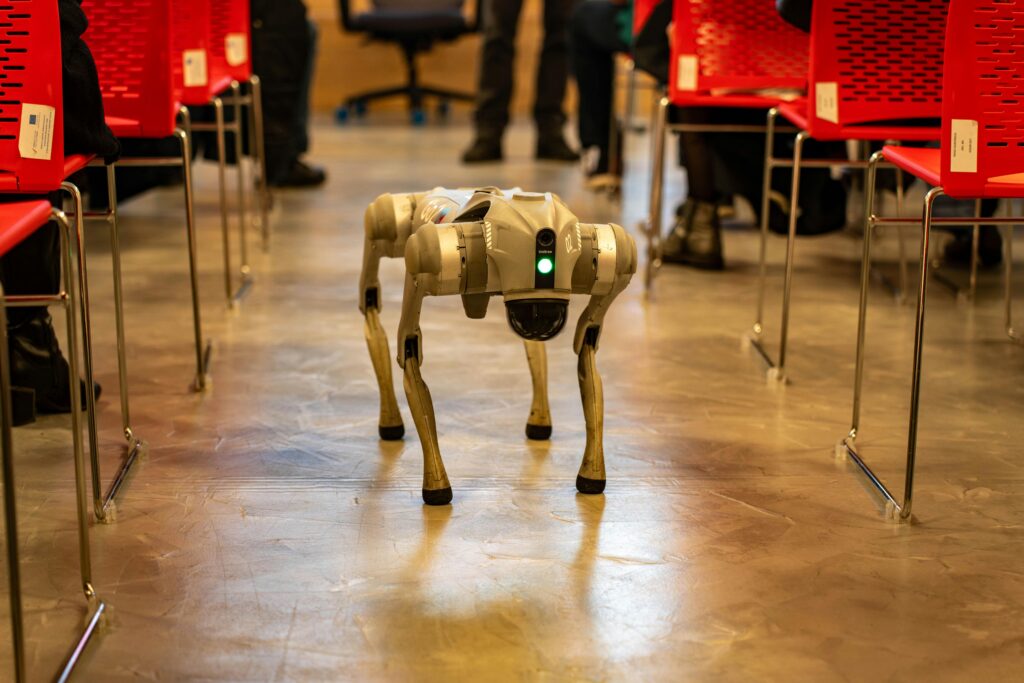Introduction
The UK Ministry of Defence has introduced robot dogs into bomb disposal operations in a groundbreaking move. This innovation aims to reduce the risks associated with human involvement in defusing dangerous explosive devices. By integrating these advanced robots into real-life bomb disposal scenarios, the UK is not only improving safety but also pioneering the use of robotics in high-risk situations. In this blog, we’ll explore the emerging role of robot dogs, the technology behind them, and the remarkable benefits they bring to bomb disposal teams.
A Revolutionary Step in Safety
Bomb disposal has always been one of the most dangerous jobs in the world. Experts risk their lives on each mission to ensure public safety. However, the introduction of robot dogs has dramatically changed this narrative. These highly capable machines now tackle hazardous materials and explosive devices without putting human lives at risk.
The UK Ministry of Defence, in collaboration with advanced robotics firms, tested these robot dogs in real-world bomb disposal scenarios. The trial proved that robot dogs can autonomously navigate complex environments and handle bomb disposal tasks with precision and efficiency. Equipped with the latest technology, they detect, analyze, and neutralize explosives from a safe distance.
This breakthrough in bomb disposal technology offers a level of safety and efficiency that was previously unimaginable. With autonomous robots handling the most perilous tasks, human personnel no longer face the immediate dangers posed by bombs.
How Robot Dogs Work
Robot dogs combine advanced robotics, artificial intelligence (AI), and specialized sensors. These machines perform tasks in environments that would be unsafe for humans, such as bomb disposal zones.
Equipped with high-tech sensors and AI, the robot dogs detect explosive materials, identify potential threats, and neutralize them autonomously. These robots can walk, navigate stairs, open doors, and assess areas that are too risky for humans to enter.
Though remotely controlled by bomb disposal experts, their AI algorithms allow them to operate autonomously as well. In some cases, the robots identify IEDs (Improvised Explosive Devices) and deploy disruptors to neutralize the device before it causes harm.
The Benefits of Robot Dogs in Bomb Disposal
Integrating robot dogs into bomb disposal operations offers several distinct advantages:
1. Minimizing Human Risk
The most significant benefit of using robot dogs in bomb disposal is reducing human exposure to danger. Bomb disposal teams no longer need to approach potentially deadly explosives. The robot dogs handle the threat from a safe distance, saving lives in the process.
2. Improved Efficiency
Robot dogs work tirelessly, without the need for breaks, food, or rest. This continuous work rate allows bomb disposal units to respond to situations faster than ever before, reducing the time spent on hazardous operations.
3. Autonomous Operation
With AI and advanced sensors, robot dogs can operate autonomously, making real-time decisions about how to handle a particular threat. This reduces the reliance on human intervention, improving both the safety and efficiency of the process.
4. Precise Task Execution
Unlike human bomb disposal experts, robot dogs do not suffer from fatigue or distraction. They focus solely on the task at hand, ensuring they handle explosive devices with the utmost care and precision.
The Latest Technology Behind Robot Dogs
The technology powering robot dogs is cutting-edge and continuously evolving. These machines feature state-of-the-art sensors that allow them to detect explosives from a distance. The sensors identify the chemical compounds often found in bombs, allowing the robots to approach with caution and determine the best course of action.
AI plays a crucial role in these robots. The machine learning algorithms enable robot dogs to analyze situations, make decisions on the fly, and adjust their actions accordingly. The AI-powered systems process data much faster than humans, allowing the robot to handle complex situations that would otherwise require expert intervention.
Moreover, robot dogs are designed to operate in difficult environments. Whether navigating narrow corridors, staircases, or uneven terrain, these robots handle obstacles that would hinder a human operator. Their quadruped design gives them superior balance and mobility, ensuring they can reach places that are typically hard to access.
The Future of Robot Dogs in Bomb Disposal
As technology advances, robot dogs will likely become a standard part of bomb disposal units not only in the UK but around the world. Their ability to safely and efficiently neutralize explosive threats will continue to change the game in public safety.
As AI and machine learning capabilities improve, robot dogs will become even more capable, allowing them to handle an even wider range of explosive devices and hazardous materials. In the future, these robots may even be used in disaster recovery situations, where their ability to navigate dangerous environments and assess threats could save countless lives.
How Robot Dogs Are Part of the Broader Robotic Revolution
Robot dogs represent just one example of how robotics is reshaping industries worldwide. From healthcare to manufacturing, robotics has revolutionized the way we approach complex problems. In bomb disposal, robot dogs only scratch the surface of what’s possible.
As robotic technology improves, we’ll likely see even more specialized robots introduced into various sectors. The ability of robots to perform dangerous tasks without putting humans at risk is a key factor driving the growing use of robots in all fields. Whether it’s firefighting, military operations, or search and rescue missions, robots are making their way into areas that were once considered too dangerous for humans.
Conclusion
The introduction of robot dogs into bomb disposal operations marks a significant milestone in both robotics and public safety. By using these advanced machines, the UK Ministry of Defence has set a new standard for performing dangerous tasks with minimal risk to human life. As this technology evolves, robot dogs will likely play an even bigger role in bomb disposal and other high-risk industries, helping to make the world a safer place.
FAQ
1. What makes robot dogs suitable for bomb disposal?
Robot dogs are designed with advanced sensors and AI technology that allow them to detect and analyze explosive devices from a safe distance. Their ability to navigate challenging environments and perform autonomous tasks makes them perfect for bomb disposal operations.
2. How do robot dogs detect explosives?
Robot dogs use various sensors, including chemical detection sensors, to identify explosive materials. These sensors detect the unique chemical compounds present in many explosive devices, helping the robots assess and neutralize threats.
3. Are robot dogs fully autonomous?
While robot dogs are capable of operating autonomously, bomb disposal experts can also control them remotely. Their AI allows them to make real-time decisions based on the environment and the task at hand.
4. Can robot dogs be used in other fields besides bomb disposal?
Yes, robot dogs are already being used in other industries, including search and rescue, military operations, and surveillance. Their versatility makes them suitable for a wide range of tasks in dangerous environments.
5. Will robot dogs replace human bomb disposal experts?
Robot dogs won’t replace human experts entirely but will work alongside them. They reduce risk and increase efficiency in dangerous situations, allowing human operators to focus on more complex tasks.
Related Video
Watch this video for more details.



